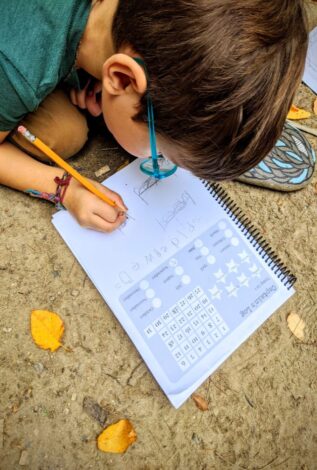How to Create a Nature Journaling Habit with Your Kids
This is part two of our nature journaling series. In part one we explore the benefits of fostering a nature journaling habit. In this article, you will learn what you need to know to create and foster a nature journaling habit with your kids.
“I see no more than you, but I have trained myself to notice what I see.” —Sherlock Holmes, The Adventure of the Blanched Soldier
As the Sherlock Holmes quote above alludes, learning to nature journal takes time. It is a process and you and your kids will be training yourself to really notice all the things you see in nature. Use the tips below to help you create a nature journaling habit with your kids, and in turn a stronger connection to the great outdoors.
How to create a nature journaling habit with your kids
- Step one: Pack a backpack or bag with a notebook (or pieces of paper) pencils, water, and snacks.
- Step two: Go for a walk anywhere outside (neighborhood, park, playground, hiking trail, etc.)
- Step three: Find a spot to sit with at least one item in sight to observe. Encourage your children to help you find the perfect spot.
- Step four: Get out the notebooks, pencils, and snacks. While everyone is enjoying their snack, briefly talk about observing nature and recording your time in nature (ideas on how are listed below). If you are doing a specific activity (more on this below as well), then go over those details at this time too.
- Step five: It’s time to nature journal! Get up close and investigate the object of your journal. Use as many senses as possible and record these senses in your journals too. Spend as little or as much time as you'd like.
What to do while nature journaling
 Photo by: Katie Fox There are so many options. John Muir Laws (which is the gold standard of nature journaling for adults) suggests including drawing, words, and numbers in each journal entry. But, it is your journal and you are exploring this activity with your children. It is meant to be enjoyable, so make it fun for your family. Here are some ideas:
Photo by: Katie Fox There are so many options. John Muir Laws (which is the gold standard of nature journaling for adults) suggests including drawing, words, and numbers in each journal entry. But, it is your journal and you are exploring this activity with your children. It is meant to be enjoyable, so make it fun for your family. Here are some ideas:
- Draw what you observe.
- Write about what you observe.
- Use numbers as descriptors (such as counting or measurements).
- Collect nature samples and tape them in your journals.
- Take photos and tape them into the journal.
- Record the date, time, weather, and/or location of the journaling activity.
- Write a poem or story inspired by your observations.
- Use the nature items to make art.
- Note your first finds in each season or year.
How to lead a journaling session with your kids
There are many ways to lead a nature journaling session with your children. It will vary depending on the skills your children already have.
- First, introduce the activity. This can be very brief and broad for young kids and more in depth and focused for older kids. Explain what the activity is and why you are doing it. Also, make sure to remind your children to use pictures, words, and numbers in their journal entry.
- Joining in and do each entry also. Kids learn best by example, so setting the example of how to nature journal is an important step.
- If you have easily distracted children (like I do), it is important to gently re-direct them back to observing nature when needed by drawing their attention back to the activity. Using phrases like, “what does the leaf look like on the other side?” or “look at all the colors on that flower,” or “how many objects is that spider web attached too?” can help refocus their attention.
- Follow the lead of your children when it comes to how much time to spend on the activity. It should take about 10 minutes for children to draw and write out observations. If one of your children feels done very quickly after starting, maybe try redirecting them gently back to the task. Don’t force it though. Fostering this habit can take time.
- Finish up with a short discussion of the activity. This can be very simple for young children or a bit more in depth for older kids.
How to foster a nature journaling habit with your kids
- Make it fun. This might be the important part in turning journaling into a regular practice. It needs to be enjoyable for everyone. So do what works for your family.
- Do it often. Pick one day each week to set aside time to nature journal with your kids. Our family journals each Monday morning on our already regularly planned nature hikes. For another family, it may be on Saturdays when their whole family goes to the park. And yet for another family, it may be done at home after they go for a walk around their neighborhood. The key is to do it at least once a week to make it part of the routine, and something the whole family can look forward to.
- Be flexible. These nature journaling ventures may often not turn out how you pictured. This is okay. If your scheduled journaling time doesn't work out, try again later in the week. If you miss it altogether, that is okay too. Sometimes, your children may see a frog (or any other nature object) and this new discovery may completely derail the whole activity. Be flexible and create space for this discovery in the journaling activity. And keep in mind you will need to be flexible in your nature journaling practice as well. While journaling with your kids sounds lovely, often you may only get a few minutes to jot down observations and will have to come back to it later. But modeling the activity is important, so keep at it.
Now get out there! Explore nature and harness your inner Sherlock Holmes and train yourself (and your kiddos) to notice what you’ve always seen! It is time to create and foster a nature journaling habit with your kids.
Additional Resources:
- Can You Take a "Hike" in the City?
- Introduction to Nature Journaling - John Muir Laws
- Nature Rich Resources for Distance Learning and Homeschooling
- Words, Pictures, and Numbers - John Muir Laws
What are your favorite nature journaling adventures?
About Hike it Baby
Editors Note:
Related Content





Comments